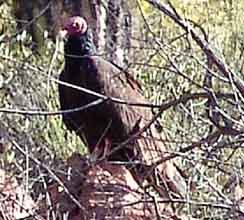Birds (Class Aves)

Main Sources: Sibley, David, 2000, The Sibley Guide to Birds, New York: Chanticleer Press; Sibley, David, 2001, The Sibley Guide to Bird Life & Behavior, New York: Chanticleer Press; Peterson, Roger, 1990, A Field Guide to Western Birds, Boston: Houghton Mifflin; Farran, John, Jr., 1988, An Audubon Handbook: Western Birds, New York: Chanticleer Press; Wheeler, Brian & William Clark, 1999, A Photographic Guide to North American Raptors, Academic Press; Steven Phillips and Patricia Comus, eds., 2000, A Natural History of the Sonoran Desert, Arizona-Sonora Desert Museum Press, Tucson; UC Berkeley Taxon Lift; and see this excellent on-line Guide to North American Birds, and see this link! -- Southeastern Arizona Bird Observatory -- a non-profit organization working toward conserving birds and habitats in our region. The organization conducts educational workshops, walks, and tours, studies bird migration patterns, and works to promote environmentally responsible developments.
 Birds are members of the Archosauria lineage of diapsid reptiles (those terrestrial tetrapods having two openings on each side of the skull), whose ancestors probably appeared in the late Permian Period of the Paleozoic Era, some 250 Million Years ago (My). The descendants of the Archosaurian line include the Dinosaurs (dominant throughout the Mesozoic Era but extinct since the end of the Cretaceous Period 65 MYa), the Crocodilians, and the Birds.
Birds are members of the Archosauria lineage of diapsid reptiles (those terrestrial tetrapods having two openings on each side of the skull), whose ancestors probably appeared in the late Permian Period of the Paleozoic Era, some 250 Million Years ago (My). The descendants of the Archosaurian line include the Dinosaurs (dominant throughout the Mesozoic Era but extinct since the end of the Cretaceous Period 65 MYa), the Crocodilians, and the Birds.
As most reptiles, birds share a color vision system superior to that of the mammals, including receptivity to Ultraviolet wavelengths, due to the possession of four kinds of retinal cone pigments rather than the three humans have (and most mammals, two). Birds see colors that we cannot even imagine, so we can only wonder at what ranges of plumage (and food-coloration) differences they can distinguish.
Though themselves descended from a line of dinosaurs, Birds evolved their own very distinctive set of specializations: "a unique 'one-way' breathing system, light yet strong hollow bones, a skeleton in which many bones are fused or lost, powerful flight muscles, and -- most importantly -- feathers." (UC Berkeley Taxon Lift)
Viewed generally, birds feed on a wide variety of foods. They lack teeth, having instead a horny beak covering the jaws and which has often evolved structurally in adapting to particular diets. Ecologically these diets involve them in prominent roles controlling insect populations and pollinating flowers and dispersing seeds of plants. (See, for example, the remarkable role possibly played by migrating plovers in conducting creosotebush from remote parts of South America into the North American southwest sometime during the Pleistocene epoch.)
 Since every living organism's need for water increases as temperature rises, while available water tends to decrease under the same conditions, we might expect that birds would find life exceptionally difficult in our warm Arizona desert, yet our bird populations are both numerous and varied. Many of our birds have developed adaptive strategies for full-time desert living -- rest during high daytime temperatures, occupying cool microclimates (even living underground in some cases), dilating blood vessels on the legs, etc.
Since every living organism's need for water increases as temperature rises, while available water tends to decrease under the same conditions, we might expect that birds would find life exceptionally difficult in our warm Arizona desert, yet our bird populations are both numerous and varied. Many of our birds have developed adaptive strategies for full-time desert living -- rest during high daytime temperatures, occupying cool microclimates (even living underground in some cases), dilating blood vessels on the legs, etc.
Other kinds of birds migrate to maintain living conditions. The insect-eaters, for example, leave cold winter areas when insects disappear, and return when insect breeding seasons begin in such locations. We have many "neotropical" migrants, species of birds who travel the Americas between productive summer breeding grounds in North America and the warmer wintering locations to the south.Our San Pedro River, which runs south-to-north and has many stretches of surface water and supports an abundance of wildlife, is one of the most important migratory corridors in our Western Hemisphere. Our Hot Springs Canyon perennial stream provides a permanent oasis along this route (while our watertanks lend more occasional support). For a list of our Saguaro Juniper birds, see this link:
Saguaro Juniper Bird List (adapted by Daniel Baker from USGS list for SPRNCA)
In the pages below we report on some of our own experiences of the incidence of various kinds of birds on our Saguaro Juniper lands. These are very preliminary efforts.
Click on the blue headings to go to pages we currently have available (in however incipient form). * Note: we are not professional wildlife photographers, just amateur naturalists who enjoy sharing images of the birds of our area. Some of them are of low resolution, some are blurred -- we still think they have some value.
Waterbirds
Raptors
Vultures
Gambel's Quail
Wild Turkey
Roadrunner et al.
Tyrant Flycatchers
Verdins & other small gray birds
Silky Flycatchers: Phainopepla
Hummingbirds
Mockingbirds & Thrashers
Wrens, Titmice, Bushtits, Chickadees & Kin
Warblers, Gnatcatchers, Kinglets & Thrushes
Grosbeaks, Cardinals, & Tanagers
Sparrows, Towhees, Finches, et al.
Woodpeckers & Flickers
Owls
Ravens, Crows, & Jays
Nightjars
Swifts & Swallows
Orioles, Blackbirds, Cowbirds et al.
Pigeons & Doves
Shrikes & Vireos
Unidentified Birds



Back to Our Lands and Their Creatures


